
Noveret universitas vestra me dedisse et concessisse Deo et ecclesiae in honore beatae Marise apud Leestune constructee et canonicis ordinis Praemonatratensis professis ibidem Deo servientibus ad Abbatiam ibidem construendam ad ministrandum ibidem imperpetuun, totum manerium de Leestune possidendum et libera et pura et perpetua elemosina, cum omnibus pertinentiis suis.
Et cum ecclesia beatae Margaretae de Leestune et cum ecclesia, St. Andreae de Aldringeham: quas ecclesias prius dederam canonicis de Buttele, unde ipsi habent cartam meam et confirmationem domini mei Henrici regis secundi quas ipsi canonici de Buttele resignaverunt ipsis canonicis de Leestune, coram domino Johanne Norwicensi episcopo et coram me et Walkelino, Archideacono, et Galfrido capellano Huberto Walteri, Magistro Renerio de Hecham, et Magistro Roberto de Waxtone et Jordano de Ros,et Magistro Lamberto, et Simon de Scales, et Magistro Waltero de Calna, et Rogero de Glanvilla et Osberto, et Gerardo; et Galfrido filio Petri, et Alano de Valoins, et aliis multis.
Quod manerium venerabilis dominus meus rex Anglorum Henricus secundus mihi dedit pro servicio meo, Quando autem eosdem canonicos ibidem fundavi concesserunt et in veritate promiserunt, quod nullam terram ement vel in vadium vel ad firmam, vel aliquo alio modo recipient, nisi quae eis grata collata fuerint in libera elemosina; et quod non capient, vel aufevrent ab aliquo hominum, qui tunc temporis, quando eos ibidem fundavi in eadem villa manserunt vel a successoribus suis aliquid de aliquo tenementorum suorum quod tunc temporis tenuerunt; sedomnia tenementa sua, eis et successoribus eorum pertinentia tenere bene et pace persericia adipsa tenementa sua pertinentia.
Hanc autem donationem feci eis pro salute memorati domini mei illustris regis
Henrici, et pro salute animae meae, et Bertha uxoris meae, et omnium antecessorum et
successorum nostrorum. Quare volo et concedo, quod praefati canonici, totum praefatum
manerium de Leestune, cum omnibus pertinentiis suis, et cum praefatis ecclesiis, habeant,
et teneant in libera et pura et perpetua elemosina, bene et in pace, libere et quiete et
integre et honorifice, et plenarie; in boscis et plano; in pratis et pascuis; in stagnis, et
molendinis: in piscariis, et turbariis et mariscis et juncariis, in viis et semitis et omnibus
aliis locia et aliis rebus, cum omnibus libertatibus et liberis consuetudinibus ad ipsum
manerium pertinentibus.
Testibus hiis:-
Johanne filio domini Regis Willielmo de Aubervill, Randulfo de Ardene, Rogero de
Glanvilla, Osberto de Glanvilla, Willielmo de Valoins, Radulfo Murdac, Ranulfo de Gedinge,
Alardo filio Willielmi, Theobaldo Walteri, Ricardo Malebise, Willielmo de Basengeham,
Rogero Walteri, Willielmo filio Willielmi de Aubervill, Thoma de Ardene.
Leiston Abbey also received Charters from Richard, Archbishop of Canterbury, Roger Bigod, Earl of Norfolk, and William de Valoins.
The Churches that belonged to this Abbey were Aldryngham, Middleton, Leyston, Corton, Theberton, Culpho, Kettleburgh, and the Chapel of Sizewell, and the Manors of Leyston, Darsham, Pettangh, Laxfield, Middleton, and Gleveringhall in Hacheston, a rabbit warren in Leiston, and a mill in Glavering.
Glanville's good works did not end here; his noble mind was not satisfied with the building of two monasteries, in which God's name might, as he no doubt intended, be worshipped for ever in those stately buildings which he had reared to his Master's honour; but, although his turrets have long crumbled into dust, and hardly anything now remains of those once religious houses, yet, as long as England lasts, Glanville's name will always be had in worthy remembrance and just appreciation.
At one time the fearful plague of leprosy raged in England, and certain good men, having compassion on the sufferers, founded, for their use, homes, or hospitals. Suffolk seems to have been visited by this scourge, for, at West Somerton, Glanville founded and endowed an asylum for thirteen persons afflicted with this disease. King Henry II. had granted him the greater portion of the Lordship of West Somerton, which he gave to his hospital there, and made it subordinate to the Priory of Butley. William de Auberville, his son-in-law, in 1235, further increased its endowment with the advowson of the Church of West Somerton, which he had inherited from him.
William de Gyselham and Isabel his wife, in the year 1277, were likewise considerable benefactors. The sum of ten pounds arising from the Lordship of West Somerton was appropriated for the support of two canons who were to serve God in the Monastery of Butley, and to pray for the soul of Ranulph de Glanville the founder. [fn 39]
It may be of interest to give the Preface to Lord Ranulph de Glanville's celebrated legal work, "On the Laws and Customs of England," and the few notes which Lord Campbell makes thereupon. There are several copies of this most ancient treatise still in existence, and in the beginning of the century an able translation was completed by Mr. Beames, Barrister-at-Law. The Lord Justiciary commences by saying, "The Majesty of the King should not merely be supported with arms to restrain rebels, and repel foreign invaders; but ought likewise to be endowed with laws for the peaceful government of the people. May our most illustrious Sovereign (Henry II.) conduct himself with such felicity both in peace and in war; by the force of his right hand crushing the insolence of the proud and the violent, and with the sceptre of equity moderating his justice to the humble and obedient, so that, as he may be always victorious over his enemies, so he may on all occasions shew himself impartially just in the government of his subjects. How vigorously, how skilfully, how gracefully our most excellent King has conducted his arms and baffled his foes is manifest to all, since his fame has now spread over the whole world, and his splendid actions have reached even the extremities of the globe. How justly, how discreetly, and how mercifully he, who loves peace, and is the author of it, has conducted himself towards his subjects is evident, since the court of his Highness is regulated with so strict a regard to equity, that none of the judges have so hardened a front, or so rash a presumption, as to dare to deviate, however slightly, from the path of justice, or to utter a sentence in any measure contrary to truth. Here, indeed, no poor man is oppressed by the power of his adversary, and the balance of justice is not swayed by love or by hatred. Every decision is governed by the laws of the realm, and by those customs which, founded on reason in their origin, have for a long time been established. What is still more laudable, our King disdains not to avail himself of the advice of such men (although his subjects) who, in gravity of manners, in familiarity with the laws and customs of the realm, in wisdom and in eloquence, are known to surpass others, and whom he has found by experience to use most despatch (as far as is consistent with reason) in the administration of justice, by deciding difficult questions and ending suits; acting now with more severity, now with more lenity, as they see most expedient."
"The English laws," writes Campbell, "although not written, may, without impropriety, be termed laws. Indeed, we adopt the maxim, "That which pleases the prince has the force of law." But I refer more particularly to those laws which evidently were promulgated by the advice of the nobles, and the authority of the prince. If from the mere want of writing only, they should not be considered as laws, then, indeed, writing would seem to confer more authority upon laws than either the authority of those framing them, or the equitable principles on which they are framed.
"To reduce in every instance the laws and constitution of this realm into writing would in our times be absolutely impossible, as well on account of the ignorance of writers as of the confused multiplicity of enactments. But there are some well-established rules, which, as they more frequently arise in court, it appears to me not presumptuous to put into writing to assist the memory, and for general reference. A certain portion of these I mean to submit to the reader in the following work, purposely making use of a familiar style, and of words which occur in legal proceedings. My object has been to instruct not only the professional lawyer, but such as are less accustomed to technical learning."
As a specimen of Glanville's work, I may give the proceedings in a suit for land, leading either to "Trial by Battle," or "The Grand Assize."
"After three reasonable essoins, which accompany the view of the land, both parties being again present in court, the demandant shall claim; in this manner:- "I demand against this A half a knight's fee, or two plough-lands, in such a vill, as my right and inheritance, of which my father was seised in his demesne as of fee, in the time of King Henry I and from which he took the profits to the value of 5s. at least in corn, hay, and other produce; and this I am ready to prove by my freeman, B, to whom his father, on his death-bed, enjoined, by the faith which a son owes to his father, that if he ever heard a claim concerning that land, he should prove this as that which his father saw and heard."
"The demand being thus made, it shall be at the election of the tenant either to defend himself by the duel, or to put himself upon the King's Grand Assize, and require a recognition which of the two has the greater right to the land in dispute. But here we would observe, that after the tenant has once waged the duel, he must abide by his choice, and cannot afterwards put himself upon the Assize.
"In the duel, the tenant may defend himself either in his own person, if he choose so to do, or by any other unobjectionable witness as his champion. But it frequently happens that a hired champion is produced in court, who, for reward, has undertaken the proof. If the adverse party should except to such a champion, alleging him to be an improper witness, from having accepted a reward, and that he is ready to prove this accusation against the champion, this matter shall be tried, and the principal duel shall be deferred. If upon this charge the champion or the demandant should be convicted and conquered in the duel, then his principal shall lose the suit, and the champion shall never from thenceforth be admitted in court as a witness for the purpose of making proof by duel for any other person. But, with respect to himself, he may be admitted either in defending his own body, or in prosecuting any atrocious personal injury, as being a violation of the King's peace; and he may also defend by duel his right to his own fee and inheritance."
"The King to the Sheriff of --------, Greeting. I command you that without delay you give possession to A of half a knight's fee in the vill of --------, in your bailiwick, concerning which there was a suit between him and B in my court; because such land is adjudged to him in my court by the duel. Witness," etc.
I add the mode of proceeding in cases of treason:-
"When any one is charged with the King's death, or with having raised a sedition
in the realm, or in the army, either a certain accuser appears, or not. If the public voice
alone accuses him, he shall be required to give bail, or he shall be imprisoned. The
truth of the charge shall then be inquired into, in the presence of the Justices, who weigh
each conjecture that makes for, or against, him. If on the trial by the ordeal, a person
is convicted of a capital crime, the judgment is of life and members, which are at the
King's mercy.
"Should, however, a certain accuser appear, and give security to prosecute his plea and propound his charge, that he had seen, or by other evidence could prove in court the accused guilty of having conspired against the King's life, or having raised a sedition in the realm, or in the army, and the accused on the other hand deny every thing the other had asserted, it is usual to decide the plea by the duel. And here it should be observed, that from the moment the duel is waged neither party can add or diminish any thing from the words employed in waging the duel, or in any other measure decline, or recede from his undertaking without being held as conquered, and liable to the penal consequences of defeat. Nor can the parties be afterwards reconciled to each other, by any other mode than the King's license, or that of his Justices."
Ranulph de Glanville, Lord Chief Justice [fn 40] of England, and Earl of Suffolk, married Bertha, daughter of Lord Theobald de Valoins, Baron of Parham in Suffolk, and a noble belonging to the very powerful house of De Valoins, the founder of which was Peter de Valoina, who entered England with the Conqueror, and received immense grants of land in Norfolk and Suffolk from that monarch. From Peter de Valoins, and his wife Alreda, who was daughter of Eudo de Rie, Chamberlain to Henry I., by his wife Rohese, daughter of Walter Giffard, Earl of Buckingham, descended Lord Robert de Valoins, the father of the above-mentioned Theobald, Lord of Parham, and grandfather to the wife of Lord Ranulph de Glanville. Lord de Valoins gave the Parish Churches of Hasketon, in Norfolk, and Parham, in Suffolk, to the Monastery of Hickley, which had been founded by a member of his family. [fn 41]
By this marriage Lord de Glanville left issue:- William de Glanville, second Earl of Suffolk, Osbert de Glanville, Matilda de Glanville, Amabella de Glanville, and Helwisa de Glanville. [fn 42]
Now in the seventh of Richard I., Hubert, Archbishop of Canterbury, who was nephew to the late Lord Chief Justice, and first cousin to William de Glanville, was Chief Justiciary of the Kingdom, and, in the absence of the King from England, probably had the appointment of these justices, an office which, according to Lingard, had been resumed, or modified for the special purpose of raising funds for Richard's wars. [fn 44] William de Glanville was also a benefactor to his father's Abbey of Leiston. Dying in 1228, he was buried at Butley Priory, which had been founded by his father. By his wife he left issue Gilbert, who succeeded him as third Earl of Suffolk. [fn 45]
Robert de Ufford, who married Sara de Vesey, inherited through her considerable estates which had formerly belonged to the Glanvilles. Their son, Robert de Ufford, was summoned to Parliament as a Baron 13 Jan. 1308, and continued to sit as such until the year 1311. He considerably augmented his estates by his marriage with Cicely, daughter and coheir of Robert, Lord Valoins, and also heiress of another branch of the Glanville family.
An account of the descent of the Glanville inheritance to the Uffords is given under the Lordships of Bawdsey, Glosthorpe, Orford, Aldringham, and Combs.
This Robert de Ufford was succeeded by his son, Robert de Ufford, Knight of the Garter, who served in the wars of Saxony in the reign of Edward II., and in the beginning of Edward III. he obtained a grant for life of the town and castle of Oreford, formerly the Glanville property, the castle having been built by Glanville, Earl of Suffolk, [fn 48] and of which Bartholomew de Glanville was governor in the days of the second Henry.
On the 16th March, 1336, Robert de Ufford was created Earl of Suffolk, as before

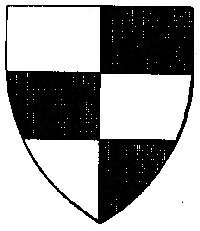
Robert de Ufford the eldest son died without issue. William, the second son, succeeded his father as Earl of Suffolk; he was also a Knight of the Garter, and a soldier in the French Wars of Edward III. and Richard II. In the 48 Edward III., a fine was levied between William de Ufford, Earl of Suffolk (representative of one branch of the Glanvilles), and William, Lord Huntingfield (the descendant and heir-at-law of another line of the same family, being representative of Emma de Grey, [fn 49] daughter of Emma de Glanville, who married Sir William de Huntingfield), for lands in Norfolk and Suffolk, and in the Lord- ship of Aldringham, that had belonged to Ranulph de Glanville, Earl of Suffolk, and Lord Chief Justice of England, the church of which he gave to his Abbey of Leiston. The property became settled on the Earl for life (obviously showing his nearer descent), and after the decease of the said William, Lord Huntingfield, on the sons of the Earl, Thomas, William, and Edmund, all of whom died without issue. These lands afterwards became the inheritance of the De-la-Poles, Earls of Suffolk, and continued until the attainder of Edmund de-la-Pole, who was beheaded in 1513, when his estates went to the Crown. The following pedigree of Huntingfield will shew the Glanville connection.
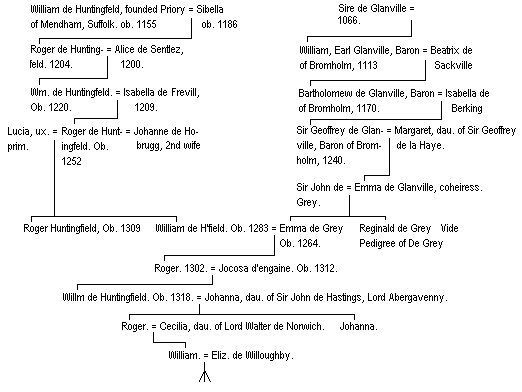
William de Ufford [fn 50] married Isabel, daughter of the Earl of Warwick, and died, leaving three sisters and coheirs; Cecily, married Lord Willoughby; Catherine, married Lord Scales; Margaret, wife of Lord Ferrers, of Groby. [fn 51]
Gilbert de Glanville [fn 52] was a younger son of Gilbert de Glanville, who lost his title, etc., for the part he took with De Montford against Henry III. Owing probably to his father's share in the rebellion, this line of the Glanvilles fell for a time to a lower social position to that which their ancestors had held. All being recorded of him is that he died in the year 1280, leaving issue Katherine de Glanville, and Sir Gilbert de Glanville, who recovered the possessions of his ancestors, and which passed by marriage of his only daughter to the Wingfields, and through them to the De-la- Poles, Earls of Suffolk.
Katherine de Glanville, the sister of Sir Gilbert, married her kinsman, John de Glanville, Lord of Wooton Glanville, in the county of Dorset (ancient Glanville Pedigree). Some authorities say that Sir Ralph de Glanville left a daughter and heiress named Elizabeth, who became wife to Sir John Wingfield, but this is undoubtedly an error. It was Sir Gilbert's daughter Alianore that married Sir John Wingfield, and she carried with her into the Wingfield family that portion of the Glanville estates as before stated. [fn 53]
In 1362 the Lady Alianor [fn 54] Wingfield, daughter of Sir Gilbert de Glanville, was a benefactor to Wingfield College, which she and her husband had founded. Among the other benefactors were Mitchel de-la-Pole, Earl of Suffolk, 1405; William de-la-Pole, Earl of Suffolk, 1428; and John de-la-Pole, 1491. [fn 55]
On the north window of the nave of East Herling Church, Norfolk, are the arms of Wingfield, quartering Fitz Lewis, Brandon, Glanville, and Honipot. Also at Durham Hall, Norfolk, were formerly the following coats in the glass, Wingfield and Bovile quarterly, impaling Glanville. [fn 56]
Sir John Wingfield, Alianor's husband, was a soldier of high reputation in the reign of Edward III., and Chief Counsellor of the Black Prince many years before 1355 when he accompanied him to Languedoc, so amply detailed by the old historian Avesburie, who has preserved some letters of Sir John's descriptive of the military operations during the campaign. The only issue of this marriage was Katherine, who became the wife of the famous Sir Mitchel de la Pole, afterwards created Earl of Suffolk, on thefailure of the De Uffords, as some authorities say through his descent from the Glanvilles.
The brother of Sir John Wingfield, Sir Thornas Wingfield, married Margaret, daughter and heiress of William Boville, Lord of Letheringham, which William Boville had inherited his lordship from another heiress of the Glanvilles. (See under Lordship of Letheringham.) [fn 57]
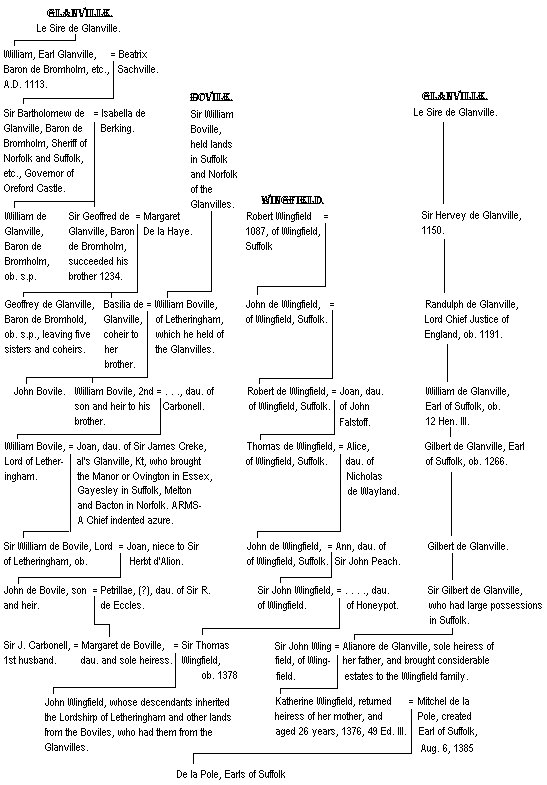
On the 24th ofApril in theyear 1326, itbeingThursdayaftertheFeastofSt. George, Richard de Glanville again answered the call to arms, and attended, probably accompanied by his men-at-arms belonging to his lordships, the muster of the Knights and Barons connected with Loose Hundred. The military writs issued during this year were, no doubt, for the defence of the country.
For what a year it was for England. On the one hand, a French army, commanded by Queen Isabella, landed there; and on the other, open rebellion reigned rampant against Edward II., who had just one more step to descend ere he touched the threshold of his tomb.
Sir Richard de Glanville left issue, Richard, William, John, and Robert. The eldest son, Richard de Glanville, succeeded his father in his Lordship of Sutton and Chalsfeld; and he dying before his wife, Ellen, she presented a Rector to Sutton Church in the year 1361. [fn 60] William de Glanville, his brother, was a Priest, and was presented by the Abbot of St. Edmund's to the Rectory of Chevington, on the 9th July, 1367. The Glanville family may have had some interest in this parish of Chevington, as shewn in a deed of confirmation, granted by Abbot Hugh of St. Edmundsbury, circa 1157, to William, son of Leo, of the Manor of Hemegrede (Hengrave), Suffolk, together with the lands in Westley, Chevington, and Saxham, which had been granted to his father by Abbot Anselm; for among the witnesses to this grant is Osbert de Glanville. John de Glanville, brother to William the Rector of Chevington, also entered Holy Orders, and in the year 1350 he was presented to the living of Hornington by Phillipa, Queen of England, and is said to have recovered the presentation from Hugh de Castello. Robert de Glanville, his brother, held lands in Bentley and Capel, 1375-1396; by his wife Agnes, he had issue Edmund de Glanville. The following two deeds relate to him:-
"Carta qua Johannes (Holebrok) concedit Johanni Card, Randulp le Clerk, Robert le Glanvilla, et Thomae le Drewre, Terras et ten: sua in Benteley (Suffolk).Testibus: Ric. de Adoriston, Tho. Cole, Ric. Crespyng et aliis. Dat. die. Ven. in Fest. St Matt. Apst. et Evang, 49 Edw. III., 1375."
It seems highly probable that Robert de Glanville's father, Richard, had granted these lands to Lord Holebroke, and he conveyed them back again to his son, as may be seen under the charter of Richard de Glanville:-
"Indentura qua Johannes Fastolf Chevaler dimittit Roberto de Glanvyle de Benteley et Agnete uxore ejus et Edmundo filio ejusdem manerium suum de Benteleye cum terris in Benteleye, Talyngston (?), Copperdon et Capel (Suffolk), tend. ad finem decem annorum reddend inde annualum per novem primos annos vj1. xiijs. ivd. Dat. die. Ven. in fest. St Mich., 20 Rich. II., 1396." Three seals of red wax are attached to this deed, i.e., Robert, Agnes, and Edmund Glanville.
"Term, 2 Edw. III., 23 October. To Hugh de Glanvill, Clerk, assigned to him by the Treasurer and Barons of the Exchequer, for the expenses incurred upon the removal of the body of Lord Edward, late King of England, father of the present King, from Berkeley to the Abbey of St. Peter's, Gloucester, in money paid to the same by his own hands for the expenses aforesaid. By mandate of Privy Seal, at Nottingham, the 10th October last past. Answered for here, etc., £5."
"4 Edward III., Mich. Term, 26 Feb. To Hugh de Glanvill, Clerk, assigned to him by the Treasurer and Barons of the Exchequer for the expenses incurred upon the removal of the body of Lord Edward, late King of England, father of the present King, from Berkeley to the Abbey of St. Peter's, Gloucester, in one tally-made this day to Thomas de Rodberg, Sheriff of Gloucester, upon the men of the town of Bristol, containing £28 6s. 8d. for the remainder of his account and paid to the aforesaid Sheriff for so much paid by the said Thomas to the aforesaid Hugh for the expenses aforesaid as appears by the letters patent of the same Hugh, acknowledging the receipt of the same money, which remains discharged in the hanaper of this term. By writ of Privy Seal, dated at Nottingham, in the first year of the present King, and remaining amongst the mandates of Michaelmas Term in the second year of the present King." [fn 61]
About 1339, Hugh, Abbot of Melsa, presented to Hugh de Glanville, who was then the Rector of Kayingham (a benefice also which Abbot Hugh was bent upon obtaining the appropriation of), the living of Easington, which Glanville retained possession of for about two years, but was induced by the Abbot to resign it into the hands of the Archbishop of York, who, immediately upon his resignation, granted to the Monastery of Melsa a faculty for taking possession of it.
This double transaction had been very profitable to Glanville, for, on resigning the living of Kayingham, he received an annuity of £40, which ceased on his being presented to Easington; for the resignation of the latter living he was to receive the large annuity of £80, equal to full a £1000 per annum of present value. This good income was to be regularly paid to him at Cambridge, and the Monastery entered into a bond of £1000 for its payment; but Glanville, in consideration of the distresses of the Convent, subsequently consented to a reduction of this annuity to 80 marks.
"Excellentissimo Principi & Domino Suo Domino Phillipo Dei Gratia Regi
Franciae illustri Consanguineo suo Carissimo Edwardus eadem gratia Rex Angliae,
Dominus Hiberniae, & Dux Aquitaniae salutem et felices ad vota successus:
"Ex querela mercatorum nostrorum Angliae, etc.
"Mandavimus districte que injunximus dilectis & fidelibus nostris, Roberto de
Burghersse constabulario castri nostri. Dovoriae & Johanni de Banquell senescallo
Pontivgravi ad inquirendum una cum Domino de Saquinvill & Montoun de Glanville.
"Militibus vestris, etc., etc. Dat. apud Dumfermelyn, 28 die Januarii, 1304." [fn 62]
William de Glanville (revert to issue of Gilbert de Glanville, Earl of Suffolk) was a younger son of Gilbert, Earl of Suffolk, and all that is recorded of him, so far as I have been able to discover, is that he left two sons, Robert de Glanville, heir to lands in Norfolk and Suffolk, 1291, and Richard de Glanville, who held lands in Oxfordshire in the time of King Edward I. The brother to the above-mentioned William de Glanville was Bartholomew, who became a Franciscan Monk. He studied at Oxford, Paris, and Rome; and about 1360 wrote "Opus de Proprietatibus Rerum seu Allegoriarum ac Tropologiarum in Utrumque Testamentum." This work was on the figurative language of the Bible, and has been published, with other pieces, frequently, many ancient copies of which are to be seen in the British Museum. [fn 63]
It is now time to turn to the female issue of Lord Chief Justice Glanville. Matilda (or Maud) de Glanville married Sir William Auberville, son of Hugh de Auberville, who died in 1139. The Auberville family held large possessions in different parts of England, .Roger de Anberville (or Odburville) held, temp. "Domesday Survey," eighteen lordships in the counties of Essex and Suffolk, and his brother William held Arley, in Herts, by grant of the Conqueror. Matilda and her husband were benefactors to the Priory of Butley, founded by their father. (See under Butley Priory.)
The Manor of Benhall was portion of the inheritance of Matilda.
By this marriage Sir William Auberville left issue Hugo de Auberville, and the following pedigree will show his descendants. [fn 64]
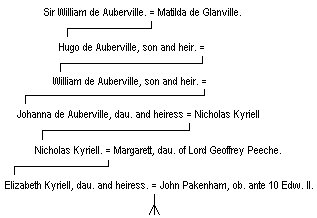
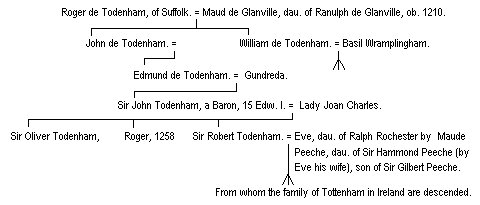
Amabel de GlanviBe, the sister to the foregoing Matilda, and daughter of Lord Ranulph de Glanville, L.C.J., married Sir Ralph de Arderne, of whom Foss gives in his "Judges of England," the following account: "Ralph de Ardeme, or Arden, was son-in-law to Ranulph de Glanville. With this connection it is natural that he should have received employment in the King's service; and we accordingly find him Sheriff of Hereford, where he had considerable property, from 1184 to 1189. In the same year, probably just before his father-in-law had retired from the Chief Justiciary, he acted as Justice itinerant in Shropshire, Hereford, Gloucestershire, and Staffordshire. He was fined £65 for not going to the Exchequer. In 1196 he was a debtor in Essex, and Herefordshire for £362 16s. 8d. for his fine; but in 1198, he recovered the King's favour. His wife died before the 6th Richard I.; for in that year Thomas de Ardern, their son and heir, was engaged in a law suit relative to the partition of the property of his grandfather, Ranulph de Glanville. He was also alive in 14th John, when a compromise took place between him and the Bohuns, with whom his father and he had been in litigation for some years. Ralph de Ardern, the grandson to the above Ralph de Ardern, was a Justiciary, and he endowed the Priory of Butley, founded by De Glanville, with half the town of Bawdesley, which he inherited as portion of the Glanville inheritance." The descendants of this marriage will be seen in the Glanville Pedigree.
Helwisia de Glanville, the third daughter of Lord Ranulph de Glanville, married Lord Robert Fitz Randulfi, Baron of Middleham, from whom descended the family of Neville, Earls of Warwick, as will be seen in the pedigree of that family, which shews how the celebrated Earl of Warwick, called the "King-Marker," was one of the representatives of the House of Glanville.
At a distance of three miles from Jervaux, Yorkshire, lie the scattered remains of the Abbey of Coverham. This house was of Praemonstratensian Canons, first founded in Swainby, in the parish of Pickhill, by Helewisia de Glanville, upon the lands in the lordship of Coverham, which had belonged to her father.
In the year, 1214 Ralph Fitz Robert, her son, translated the Abbey from Swainby to Coverham, near to his manor-house at Middleham, where an abbey was built and flourished until 1538, the gross annual value then being £207 14s. 7d.Helwisia was buried at Coverham; the issue of this marriage was three sons, two of whom died without issue, but the third, Ralph Fitz Robert, married Mary, daughter of Roger Bigod, [fn 66] Earl of Norfolk, and by her had issue two sons, the elder, Ranulph Fitz Ranulph, Lord of Middleham, married Anastacia, daughter of William de Percy, and he dying in 1270, left Mary, an only daughter, and sole heiress, both to the Glanville and Middleham property. She married Ralph Neville, Lord of Raby, who, dying in the 55 of Henry III., was succeeded by his son, Ralph Neville, Baron of Raby, who now represented the Lords of Middleham and a branch of the House of Glanville.

Having now given an account of Ranulph de Glanville, Earl of Suffolk, and Lord Chief Justice of England, and his descendants, we must proceed with the other issue of Sir Hervey de Glanville, Banulph's father (vide p. 26).
Gina de Glanville, the Justiciary's sister, married twice, her first husband being Alfred de Murions, by whom she had issue Gaufry and Roger, who were alive in the 11th John; Gina's second husband was Adam de Biannery, by whom she had a son called Adam, also living in the 11th John. [fn 67]
Alicia de Glanville, sister to the preceding, married Geoffrey de Lodnes. In the year 1209, Hubert de Randeston sued Geoffrey de Lodnes for a carucate of land in Ratelesden of his inheritance, which William de Bandeston, his brother, held in the reign of Henry II.; but Geoffrey de Lodnes pleaded that he had inherited the land by his marriage with Alicia, the daughter of Sir Hervey de Glanville, so that Robert de Creke, who married the daughter and heiress of William, and granddaughter ofHervey, ought to warrant it. The above-mentioned Geoffrey de Lodnes was descended from Goceline de Lodnes, Lord of Loddon, Norfolk, who held five fees there in 1110.
William de Glanville, brother to the preceding, married, as some authorities affirm, a daughter of William, second Earl of Surrey. This lady was married twice before she espoused De Glanville, her first husband being Roger de Newburgh, Earl of Warwick; and second, William de Lancaster, Baron of Kendal. William de Glanville left a daughter and sole heiress, Agnes, who also, on the death of her uncle, Roger de Glanville, became his heiress, as will be afterwards seen.
This Agnes de Glanville [fn 68] married Sir Robert de Oreke, son and heir of Sir Bartholomew
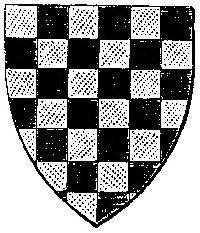
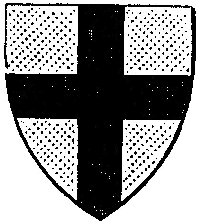
Roger appears to have been connected with his celebrated brother. Lord R. de Glanville, in the administration of justice. He was a Baron of the Exchequer in the 30th of Henry II., 1174, for we find him, in the company of the Bishops of Ely and Norwich, Hubert Walker, and other Barons of the Exchequer, presiding at the trial of Mathew Martel, who came and acknowledged before the Barons of the Exchequer that he claimed no right in the meadow called Holm; and in the year 1185 he was amerced £10 for not going to the Exchequer when summoned. On the 6th June, 1189, he was appointed Sheriff of Northumberland. [fn 69] Roger gave to the Abbey of Leiston, which had been lately founded by his brother, the church of his Lordship of Middleton for the souls of himself, Gundreda his Countess, of his father and mother, of Christana his late wife, and for that of Hervey de Glanville his brother.
In the year 1160, when the passion for building monasteries had attained its height, Roger de Glanville and the Countess Gundreda his wife founded the Benedictine Nunnery at Bungay, and dedicated its church to St. Mary, and the house to the honour of God and the Holy Cross. The site of this building was on the summit of a gentle rise lying contiguous to the eastern ramparts of the castle. The founders appropriated to their monastery the benefices of Mettingham, St. Andrew, St. Lawrence, and St. Margaret Ilkelshall, and also St. Mary and St. Thomas in Bungay. The Church of Roughton in Norfolk, a rectory valued at eighteen marks, was likewise appropriated and its revenues added to their gifts. Roger Bigot granted the nuns his watermill at Wangford, and confirmed to their use big lands of Limburne in Homersfield with all their appurtenances in perpetual alms, excepting service to him and his heirs and the payment of eightpence per annum, the which grant and confirmation he made to them for the good of his soul, and the souls of his father and mother, and of all his ancestors and friends.
In the reign of John, William de Bigod disputed the title of the nuns to a part of Roger and Gundreda de Glanville's endowment. The Prioress contended that the disputed property, which seemed to have been a carucate of land lying in Kove and Weston, had been granted by Gundreda, who had full power to do so by her seneschal, who put her in full possession. She rested her claim upon the testimony of Roger Bigod, who witnessed the gift, and relied on the justice of her country. The issue of this suit was in favour of the Prioress.
The whole of the endowments were confirmed to the Prioress and sisters by King Henry III., but many of the lands were not specified in Henry's charter.
John de Bedingfield, Prior of Aldeby, was appointed by the Prior of Norwich, in 1355, to take the confessions, to absolve, and to enjoin the penances of the Prioress and nuns of Bungay. In the time of Edward I. the convent contained a Prioress and fifteen sisters, and at the dissolution Cecilia Falstolf was Prioress with eleven nuns. The Priory and lands, etc., were granted to Thomas, Duke of Norfolk, in 1537. The seal [fn 70] of the Prioress Maria de Huntingfield, A.D. 1200, was: A matrix of silver, small, oval; the Virgin and Child seated on a throne; beneath them is the Prioress or a nun praying under an arch. The legend
Roger de Glanville, no doubt, accompanied his brother, the Chief Justiciary, to the Crusade, for on the 28th April, 1192,"Die Martis ante Festum Sanctorum Apostolorum Philippi et Jacobi, Rogerus de Glanvilla, a candida custodia profectus (Blancheguard) cum sociis suis ante portas Jerusalem potenter transiens quosdam Saracenos interceptos ad vincula coegit et secum reduxit captivos," and the next day (29th) King Richard took some Saracens prisoners between Blancheguard and Gaza; Roger also, in company with Randulph de Tilli, Humfrey de Velli, and Robert de la Lande, attempted an escalade of the walls of Acre, but they were repulsed by the Saracens, although they managed to save their ladder; the date of this was in 1190. Roger was dead, without issue, in 1199, when his second wife, the Countess Gundreda, paid a fine to the King for licence not to be compelled to marry against her will; and in the same year she brought a lawsuit against Robert de Creke for certain lands which he had inherited with his wife, Agnes de Glanville, daughter and heiress of William, and niece and heiress of Roger de Glanville, as before stated.
In the Lordship of Earsham, Norfolk, there was a manor which belonged to William de Freney, who gave the tithes of the demesne of it to the monks of Castle Acra; it afterwards came to Roger de Glanville, who confirmed that gift.
 Go to
Go toIndex to Book |
 Go to
Go toPrevious Page |
 Go to
Go toNext Page |
 Go to
Go toJay's Genes |